Today we will be taking a look at a fairly popular standing desk brand, The GeekDesk. Once known for leading the revolution of standing desks, the GeekDesk has slowly lost a lot of its fame as the market has continued to become more saturated. I was excited to get the opportunity to bring in the most recent version that included a traditional cross support. They have made it a point with their marketing material to reinforce their desks stability. Let’s take a closer look and see how the GeekDesk fared.
Full Disclaimer: We are an office furniture dealer and sell some of the standing computer desks we review. To learn more about the products we sell, our review process and why you can trust us, please visit: Why we’re different. Who is BTOD.com and The Breakroom Blog?
OEM Manufacturer
The GeekDesk current OEM manufacturer is E-Young International. According to their website, they have been manufacturing furniture for 15 years. However, based on closer inspection it appears that E-Young is really just a frame manufacturer. Specifically manufacturing the feet, upper desktop supports and cross frame sections. After looking at their electronics and opening up the columns I found components that are identical to those manufactured by JieCang Linear Motion Technology.
As with all of the electric standing desks I review, I always try to find out who the OEM manufacturer is. This gives you a better understanding of how different a desk may be from another brand. It’s always interesting pulling the desks apart to learn who is really making the important components of each electronic standing desk.
GeekDesk Review Links
– Specs / Pricing / Features
– Assembly Process
– Stability Testing
– Electronics
– Column, Foot and Frame
– Motor and Gears
– Glide Systems
– Testing The Specs
– What I Like
– What I Don’t Like
GeekDesk History
According to the GeekDesk website, the GeekDesk idea started with a back injury from its founder, Donovan McNutt. Working as a software developer, he found the typical “office chair prescription” wasn’t the right fit for his needs. He would search out an adjustable height desk only to find out that in those days the options were expensive and very limited.
Fast forward to 2010, GeekDesk was on the map and being featured in publications such as the New York Times and Washington Post. As one of the first companies to be known as a standing desk brand, their company flourished with growth.
From their first GeekDesk version 1, that was manufactured by Conset, to their current version 3, GeekDesk’s goal has always been the same. Support people and provide them with a way to work that is more enjoyable than what is typically found for desk-bound office workers.
Product Specs (Per GeekDesk.com)
Height Adjustment Range: 23.5” to 49.5”
Travel Speed: 1.10” to 1.38” Per Second
Weight Capacity: 275 lbs.
Adjustable Foot Glides: .5″
Noise Level: 49 dB
2025 GeekDesk Pricing
Only available on Used Market
Features
- Dual-Motor lifting mechanism
- Strong and durable steel frame construction
- Easy assembly
- Two-year warranty on electronics and five years on frame
Packaging
We only purchased the GeekDesk frame, so I can only comment on the packaging for that portion of their desk. Overall, the frame packaging was very good. Using cut foam to pack the columns, they arrived in perfect condition. The cross support, upper cross-frame and desktop supports shipped in a separate box. They were wrapped in bubble wrap and also arrived in excellent condition. While the frame I ordered only had to travel from Illinois to Wisconsin, I’m confident this packaging would hold up well across the country.
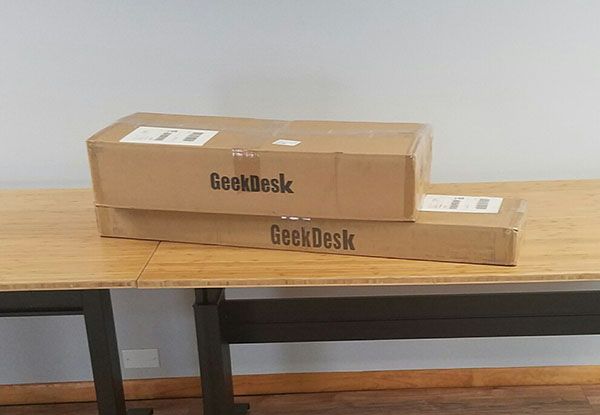
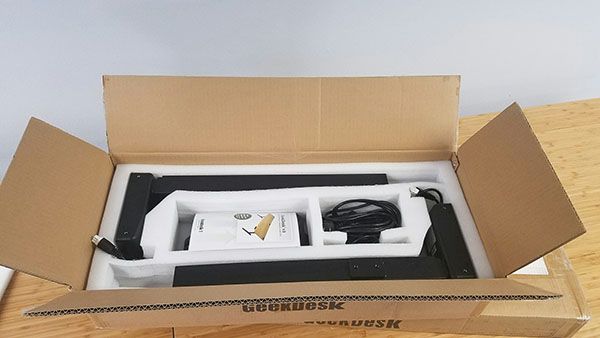

Assembly (30-60 Minutes)
The assembly for the frame was straightforward and one of the easier frames I have assembled. The hardware was clearly labeled with individual bags that were labeled for the hardware inside. Overall I believe that the assembly should take most advanced users about 30 minutes with a helping hand. If you aren’t as advanced it could potentially take up to an hour. Overall, there weren’t any real pain points with the assembly.
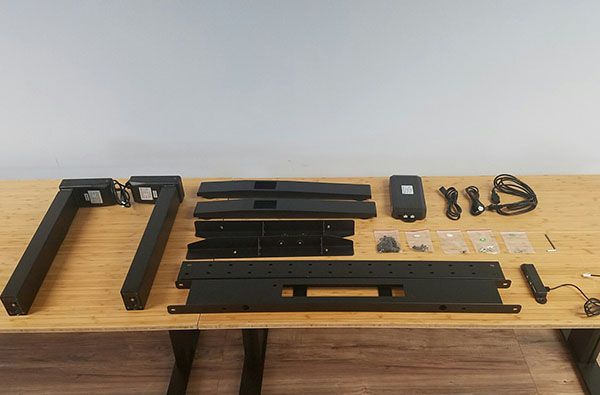
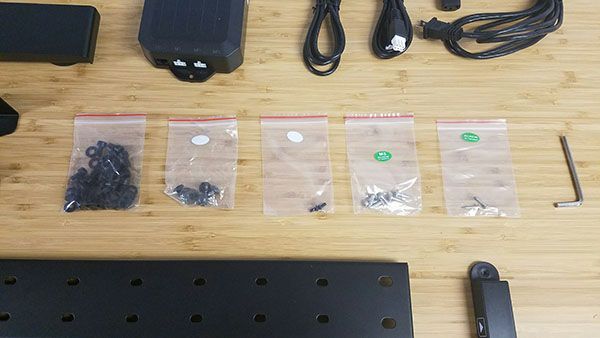
Stability
I was excited to get the GeekDesk up and running; it was only the second electric standing desk I have tested to include a one-piece cross support. Our VertDesk v3 is the first. I have also tested the StandDesk Simple which includes an expandable cross support that was less than impressive. I could tell right away the GeekDesk had a chance to be one of the more stable desks I had tested. If you’ve read my reviews you know how important stability is to me.
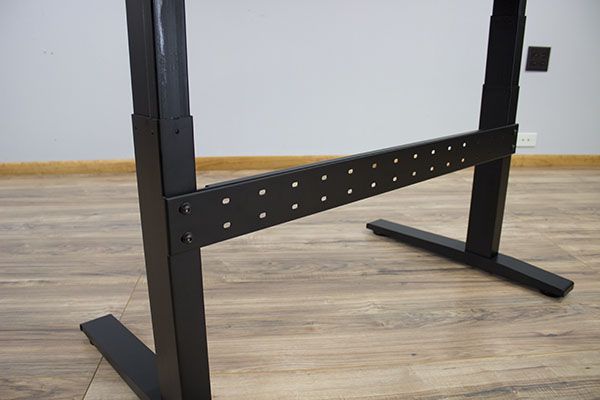
Left to Right: The first test that I performed was the wobble test. The GeekDesk excelled through almost all of the heights, with only a small amount of wobble beyond 46”. This was minimal and wouldn’t impact your work.
Note: The main culprit for the swaying was because of the placement of the cross support. With a two-stage set up, the top of the bottom column is only 20.25″ off the ground. Once the desk is fully extended, the distance from the top of cross support to the bottom of the desktop is 31.75″ inches.
Front to Back: The front to back or rocking test for the GeekDesk was about average. Once I rose it above 38” it began to show small signs of a rocking motion. It wasn’t until you reached 40” to 41″ tall that the motion became significant and could potentially impact your work.
Note: As I mentioned in all of my reviews, you have to make sure to fully tighten all hardware. As standing desks become extended the motion will become exaggerated. If your hardware is loose, all standing desks will have bad wobble and rocking motions.
Electronics
The electronics from the GeekDesk were less than impressive. Currently using a dated version of the JieCang control box, the GeekDesk electronics could us an update. We currently have a Jarvis frame in our office that is about two years old. I was able to verify the GeekDesk is using the same larger control box system found on this Jarvis Desk.

The v3 also includes one of the bulkier up/down switches I have seen. Looking closer at the GeekDesk website, the Max version also utilizes a dated switch as well. Both could use an update.
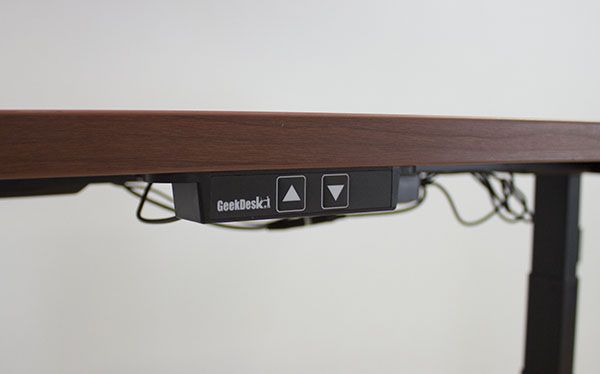
Similar to other JieCang electronics, this version of the electronics does not offer an overload protection system. While the GeekDesk frame was able to easily lift all weights I tested, when 350 was loaded onto the desk it started to make clicking sounds in motors/gears. This is a bit concerning as the desk should automatically shut off when overloaded and this was not the case with the GeekDesk.
Foot, Upper Support and Cross Frame Build Quality
When looking at just the foot design, upper supports and cross frame I was impressed with the GeekDesk’s build quality. I think that E-Young International and GeekDesk have done a good job to improve upon JieCang’s own version of their desk. The feet were very sleek and the paint on them was done to perfection. One of the better-looking feet I have seen in the mid-range category. They didn’t feel overly bulky or overdone. All of the screws aligned nicely and created a fairly solid connection. My only concern with so many bolts connecting upper support and feet is the potential for loosening over time. My suggestion would be to use a product such as Loctite to ensure a secure connection. It would also be recommended that every six months you check to see that all of the bolts are still tight.

JieCang Column Build Quality
As mentioned early in the post, I talked about how GeekDesk’s OEM uses the JieCang electronics and upright columns. This isn’t an uncommon practice, because there aren’t a large number of actual manufacturers for the columns or electronics themselves. When I cycled the GeekDesk up and down a handful of times; it started to show the white grease across the columns just as Uplift Desk and Jarvis Desk had previously. After doing a full round of testing on the GeekDesk, I decided to open the columns on the v3 and the Jarvis desk. By doing this I would able to verify that the inner workings were the same.
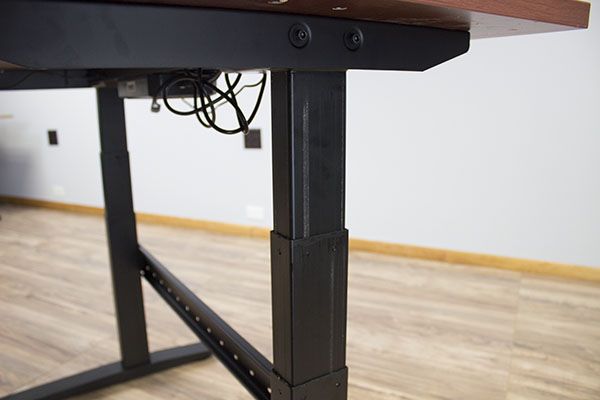
What I found was that they were exactly the same. This included the same motor, with the same gear system and glide systems. I also quickly realized that the over greasing issue was throughout the entire inside of the columns. The white grease that shows on the outside of the column will be an ongoing problem for owners of any JieCang frame. It was oozing out between the columns and worse than I had expected. The same thing existed within the gear system. With a different type of grease used, but it was a significant amount.

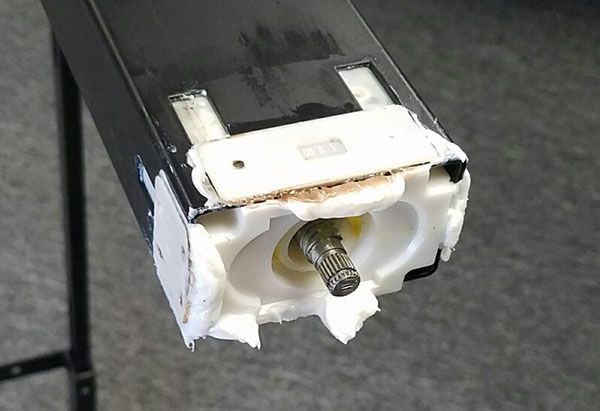
The two-stage gear system used on the GeekDesk looked to be of good quality. However, the over greasing is still a concern. I am not sure why they believe there needs to be so much grease to make the desk function properly. We have cycle tested our VertDesk v3 extensively, with minimal amounts of grease and it held up extremely well. To me, it just appears to be messy and a lack of real quality control with the JieCang technology.

Warranty
Unfortunately, the GeekDesk doesn’t carry a very strong warranty, especially when compared to others in the class. With one of the most expensive price tags, the GeekDesk comes with only a two year warranty on their electronics and five years on the frame. This is concerning as they are currently using dated electronics from JieCang. Almost all of the competitors offering similar electronics have warranties that range from three to seven years.
Testing The Specs
Height Adjustment Range: 23” to 48.75” (without top)
True. With the use of the adjustable glides we were able to get a range that was very close to this.
Adjustment Speed: 1.1” to 1.38” Per Second
We were able to consistently hit 1.32” to 1.34” per second, no matter the load that we added to the desktop.
Noise Level: 49 dB
False. The noise level was consistent with other JieCang frames. It averaged 59 decibels. While it is noticeable in a quiet room, it isn’t an annoyance and wouldn’t be an issue in most environments.
Weight Capacity: 275 lbs.
True. The GeekDesk had no issues hitting the conservative max rating shown by GeekDesk. When I loaded the desk to 160 lbs, it maintained the speed of 1.33” per second. It was even consistent with a speed of 1.32” with a max load of 275 lbs.
What I like
Easy Assembly Process
The GeekDesk has done a great job with the assembly process of their frame. Of the electric standing desks I have tested to date, it was one of the easiest to assemble. All of the bolts screwed into place with ease and there wasn’t any real pain points during assembly. Because of the weight of the desk, I would suggest having a second pair of hands to help you move the frame around. Otherwise, it shouldn’t take longer than 30 to 60 minutes to assemble the complete frame and desktop.
Lack of Wobble with Traditional Cross Support
It’s unfortunate to see how many of the standing desks in the mid-range decide to go without the traditional cross support. The GeekDesk is a perfect example of why it is so important when reducing the wobble at standing height. They did a great job using a single piece cross support, eliminating moving parts that would ultimately reduce the effectiveness of the cross support. From a wobble standpoint, it was almost as stable as the VertDesk v3. Had it been a single-stage column versus the two-stage, it would have likely been the same.
Range of Motion
With a two-stage column design, the GeekDesk is able to offer a wide range of adjustment. With the use of our 1 ⅛” thick desktop our range of motion was 23.5” up to 49.5”. This is great for users that are 5’3” and up to 6’ 8”. With the use of a keyboard tray, it will work for users that are shorter than 5’3”.
Packaging
I was impressed with the level of packaging found with the GeekDesk frame. Unfortunately, I decided to go without a desktop for this review so I am unsure how well those are packed. If they’re anything like the frame though, it should be more than adequate. The frame arrived to me in great shape and should have no problem making it across the united states on a FedEx ground truck. Because GeekDesk decided to use two boxes versus one typically used on JieCang products, they were much more manageable.
Weight Capacity
GeekDesk currently advertises a conservative 275 lbs weight capacity with the standard v3. Through our testing, we were able to easily lift that capacity and more. The speed at which the desk adjusted up and down remained consistent no matter the capacity on the desk. Because they utilize a cross support, I would feel much more confident loading the GeekDesk to max capacity than the other JieCang models.
What I don’t like
Over Greasing of Columns
One of the concerns with all JieCang frames is the over greasing. Not only is it an eyesore and potentially messy in your office, but it could significantly impact the life of your frame. As your desk is cycled up and down, there is the potential to pull dust, dirt and hair into the columns through the grease on the outside of the columns. As shown on the Jarvis desk that we pulled apart, with only a few hundred cycles up and down the dirt inside the columns scratched and wore down the glides unevenly. This same dirt has the potential to work its way into the gear system since it is also over greased and mostly exposed on the inside of the column.
Short Warranty
The fact that GeekDesk is only warranting their most important components for two years is disappointing. With one of the higher price points in the mid-range category, I would expect it to carry a warranty of a minimum five years. Competitors such as the Uplift Desk and Jarvis desk both include warranties of seven years on the same or similar components.
Price Point
In continuation of the previous section, the price point on the GeekDesk is 30% higher than comparable desks in the category. While the added stability is nice when compared to the other JieCang frames, the VertDesk v3 offers better stability for significantly less money.
No Overload Protection
Having a desk as powerful as the GeekDesk , overload protection is a must. Without it, you run the risk of burning out your motors or breaking gear components inside the columns.
Final Thoughts
Getting the opportunity to try out the most recent version of the GeekDesk had its ups and downs. Depending on your specific needs the GeekDesk could potentially be a good fit. A large 26” adjustment range, conservative 275 lbs lifting capacity and wobble-free experience were a few of those perks. A dated electronics pack, over greased column issue and short warranty, could be a deal-breaker though. With less expensive alternatives out there, you are likely to find a product that will better suit your needs and save you a few bucks at the same time.





